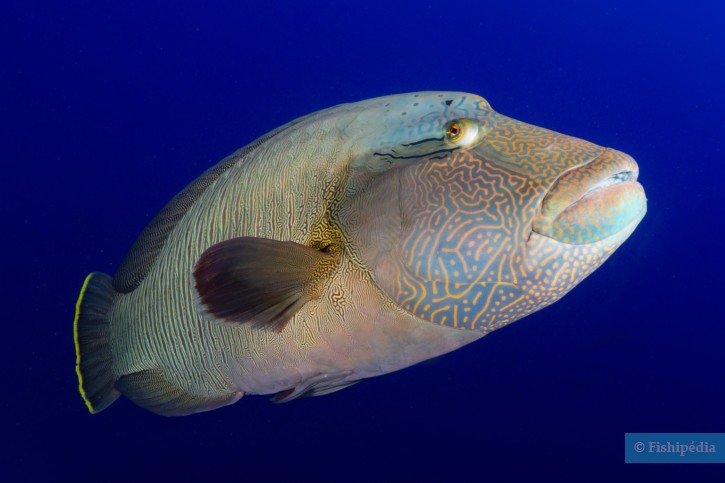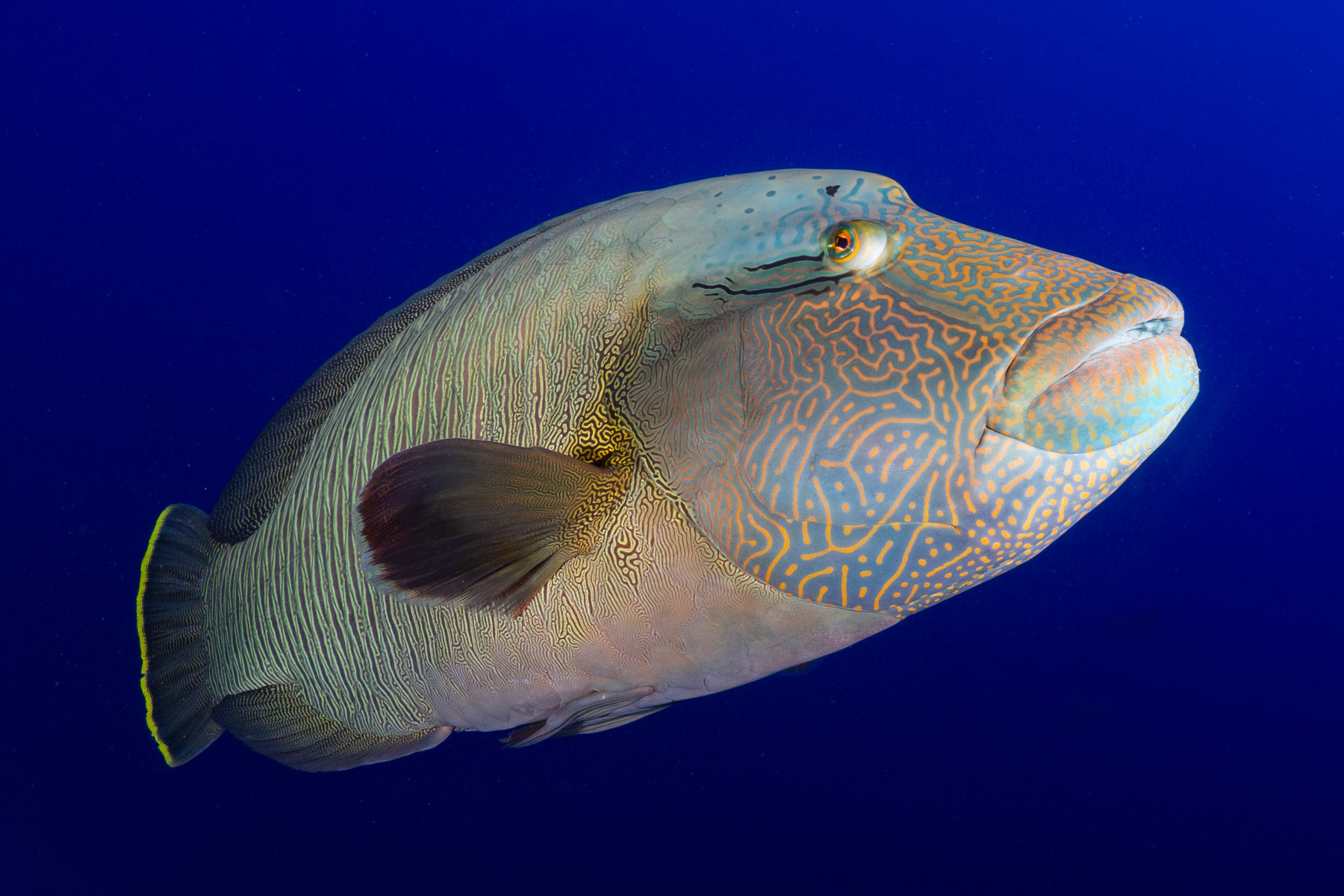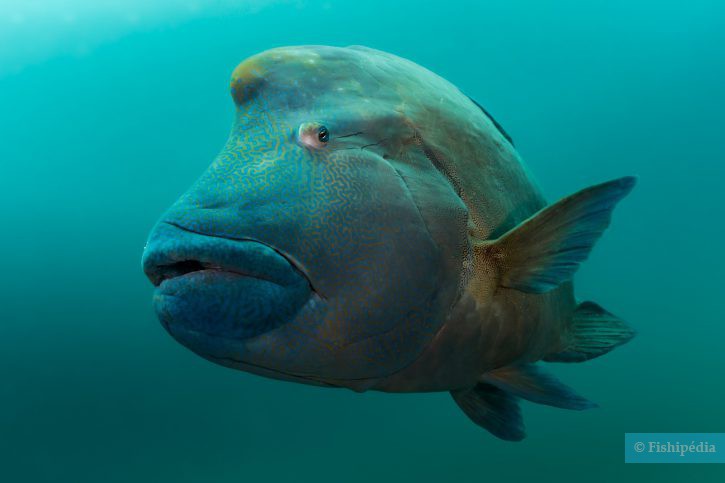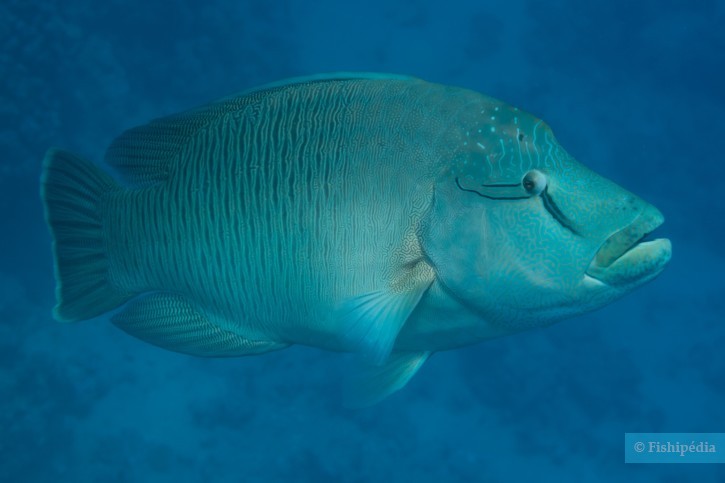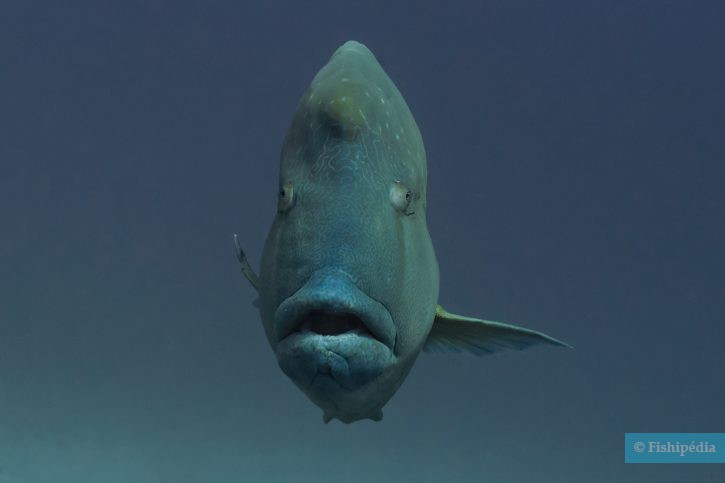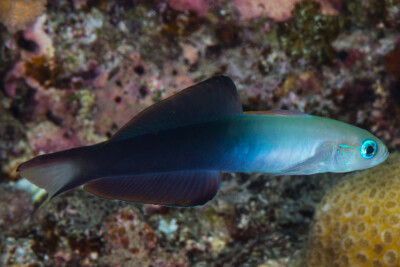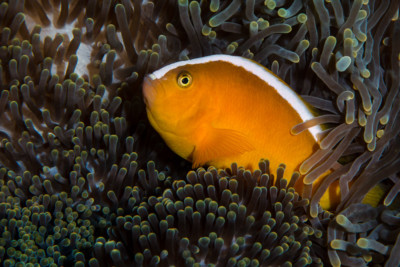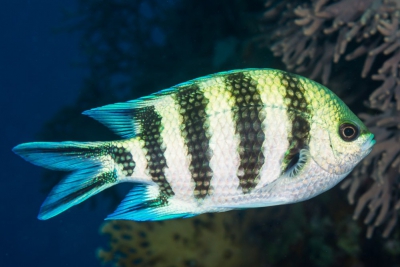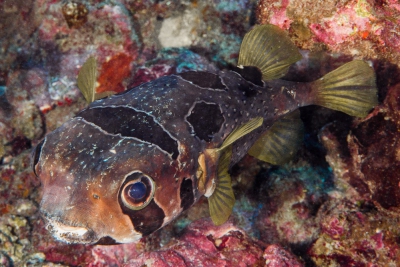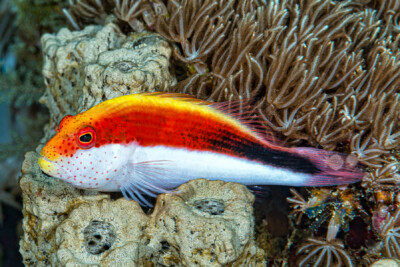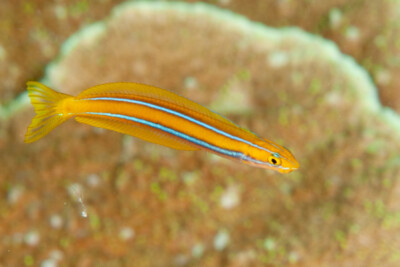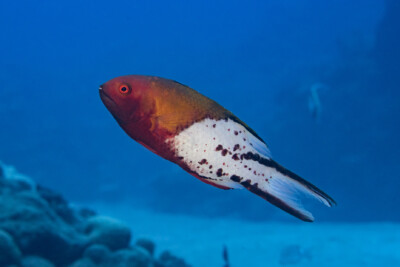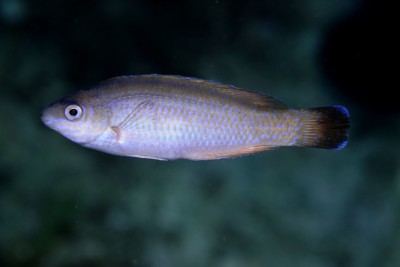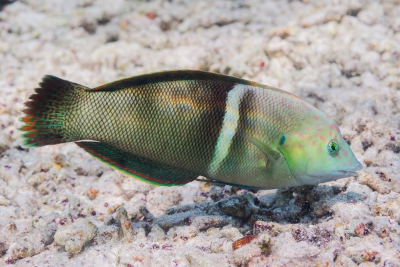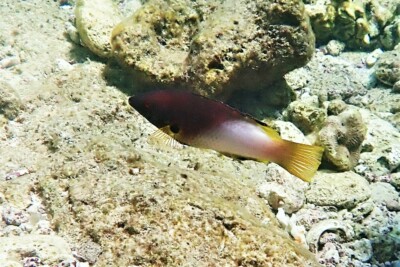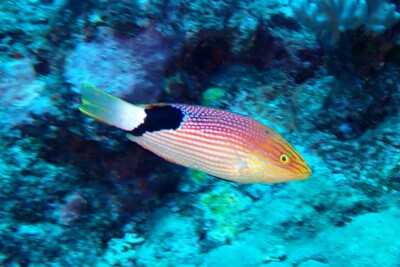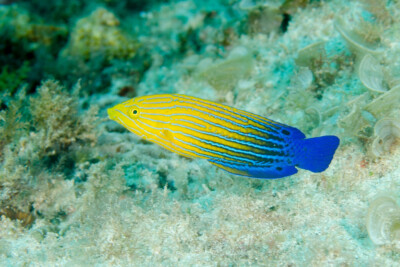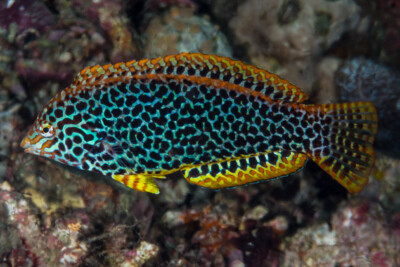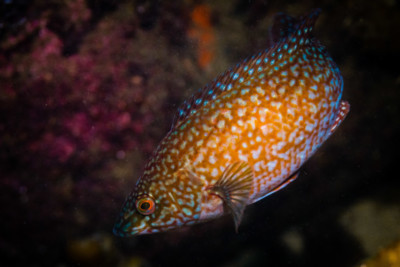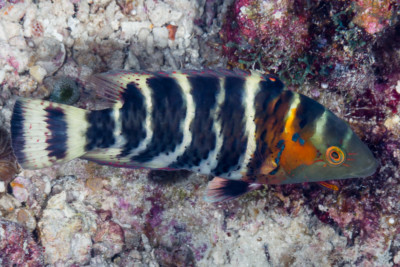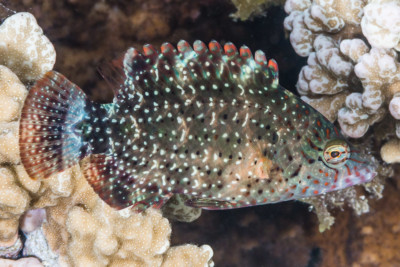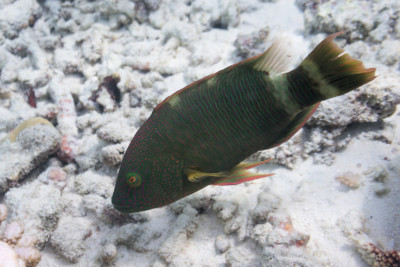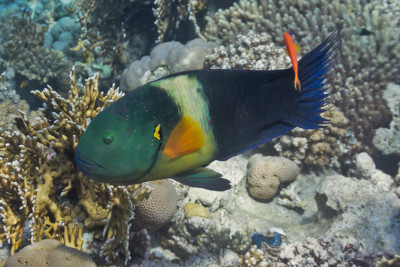Introduction
The humphead wrasse, Cheilinus undulatus, is an iconic species of coral reefs. It lives in most of the Indo-Pacific region, from the Red Sea to New-Caledonia.
This fish is the largest member of the wrasse family, with some rare specimen reaching a size of 2 meters long, hence the occasional nickname of „giant wrasse“.
This species has been subject to intensive fishing because of its much appreciated flesh. In addition, the humphead wrasse is a territorial fish which makes it easy to hunt. It has now become a rare fish, with a maximum population density rarely above 20 adults for 10,000 m². The species is considered as endangered by the IUCN and has been registered in Appendix II of CITES.
Who is it?
Genus Cheilinus
These kinds of fish belong to the Labridae family, more commonly called wrasses. In this family, a phylogenetic study describes two subgroups of the Cheilinini tribe, in which genus Cheilinus is included. This genus is close to Doratonotus, Epibulus, Oxycheilinus and Wetmorella genera. Although most of the species of genus Oxycheilinus were originally classified into the Cheilinus genus, in 2020, only 7 species are officially described as Cheilinus members.
All of these 7 species are predators in coral reefs. The larger species, including humphead wrasses, are on the highest levels of the food chain. These diurnal and territorial fish are easily caught by fishermen and hunters. All species are in danger of extinction.
Their body is moderately compressed, with a length equal or superior to the head. The colored patterns on their bodies often includes distinct vertical bars or marbling, or light sparse spots. Beside the wrasse family, these fishes are regularly confused with parrot fishes, such as Calotomus, Cetoscarus or Scarus fish.
These oviparous fishes form distinct pairs for reproduction. In addition, Cheilinus wrasses are protogynous, meaning that they are born female and then some of them turn into male. While growing, juveniles change color and sometimes patterns too.
Morphology
-
Average size60 cm
-
Maximum size200 cm
-
Longevity32 year
-
Patternponctuations
-
Average size60 cm
-
Maximum size200 cm
-
Longevity32 year
-
Patternponctuations
How to recognize This fish ?
The humphead wrasse is a bicolour fish. The body of an adult specimen is mostly blue and olive-beige with a vertical dark bar visible behind pectoral fins. Its head is blue-green to blue, covered with irregular undulating yellowish lines. Some yellowish dots can also be seen between those lines. Two black lines are extending posteriorly from its eyes.
Juveniles have a lighter to white body with dark bars and black prominent lines extending posteriorly from their eyes. In addition, two lines are extending diagonally up and back from the eyes and two other extend in front of the eyes and downward on their snout.
Adults develop a large hump on their forehead which can protrude anterior to their eyes. Jaws and lips are prominent, as well as 2 strong canines in each jaw. Dorsal and anal fins of adult specimen are very pointed and reach posterior to the caudal-fin base.
Humphead wrasses can be up to 2 meters long with a record weight of 190 kg. However, most of the adults observed measure around 60 cm.
Behaviour & Life cycle
-
dietcarnivorous
-
Sociabilityliving as a couple or alone
-
territorialYes
-
Way of livingdiurnal
The humphead wrasse is mostly a solitary fish, but, on some rare occasions, pairs have been observed. This territorial species hunts accross its living area by day. At night, this fish finds shelter in reef caves or sometimes under coral ledges. Juveniles like to live in coral-rich areas of lagoon reefs, where Acropora corals profuse. Seagrasses are another habitat where they can be observed.
The humphead wrasses can become aggressive with other territorial species. It eats mostly molluscs, fishes, urchins and various invertebrates. This fish is one of these rare predators able to eat toxic animals such as sea hares, boxfishes or some specific starfish species.
Reproduction
-
Reproductionovipare qui pond en eau libre
-
Hermaphroditeprotogynous
Humphead wrasses are oviparous and spawn in open water. During the breeding season, groups of tens to hundreds of fishes are formed. On this occasion, males and females gather at the surface of the water and expel spermatozoids and ovules.
This species can live up to 30 years old and reaches sexual maturity quite late (between 5 and 7 years old when they are 50 cm long). This late maturity makes it therefore even more vulnerable to fishing pressure.
Similarly to others species of the genus, humphead wrasses are always born female. While growing, some fishes will change into male. This phenomenon is called protogynous hermaphroditism (sequential hermaphroditism). Therefore, most of the young adults observed are female whereas males are frequently more than 1 meter long.
Harmless species
This species does not represent any particular threats to humans when encountered in its natural environment.
Origin and distribution
Geographic distribution & Conservation
A WWF report estimates that the population of the humphead wrasses has been divided by two during the last 30 years.
In several Pacific countries, the humphead wrasse has a significant cultural value. Despite its rarefaction, this species is still one of the most popular reef fish exported, especially juveniles which are either sold or made captive. In most of the fishing areas, the population density has largely decreased and the average body size has become smaller.
This phenomenon has been observed in Southeast Asia in particular where humphead wrasses have almost completely disappeared from several areas. The last specimen are now hunted with cyanide, by night, in spite of regulations banning that. The humphead wrasse was considered as a vulnerable species until 1996 and has recently been classified as an endangered one. Unfortunately, despite several attempts, no successful reproduction under captivity has been achieved. Ongoing researches aim at finding long-lasting solutions in order to protect this iconic species. These researches will also be useful for most of the other large reef fishes.
Conservation status of populations (IUCN)
What is its habitat?
Natural environment characteristics
-
Temperature25 - 30 °C
-
Depth1 - 100 m
Biotope presentation
Humphead wrasses have been observed up to 100 meters deep. Larger specimens live in deeper areas, in steep outer reef slopes and channels. Some of them live also in seagrasses.
Species of the same biotope
Fishkeeping
Not recommended
We do not recommend keeping this species in an aquarium. It has unpredictable needs which, if not met, generate significant stress, potentially leading to a shorter life expectancy, an interruption of its growth or the development of pathogens.
To go further
Sources & Contributions
Participation & Validation
The Fishipedia team and specialist contributors are committed to providing high-quality content. However, although the information comes from scientific sources or testimonials from specialists, the cards may contain inaccuracies.

Benoit Chartrer
Translation
Translation done with the valuable contribution of our translators, who make this information available to a wider audience. We sincerely thank them for their commitment.
Bibliographic references
- - GBIF
- - The Humphead Wrasse, Cheilinus Undulatus: Synopsis of a Threatened and Poorly Known Giant Coral Reef Fish - Y. Sadovy - P. Labrosse - Y. Letourneur - P. Lokani - T.J. Donaldson - Reviews in Fish Biology and Fisheries - 2003.
Scientific partners
Tags
Species of the same family
Same genus
Species of the same biotope
